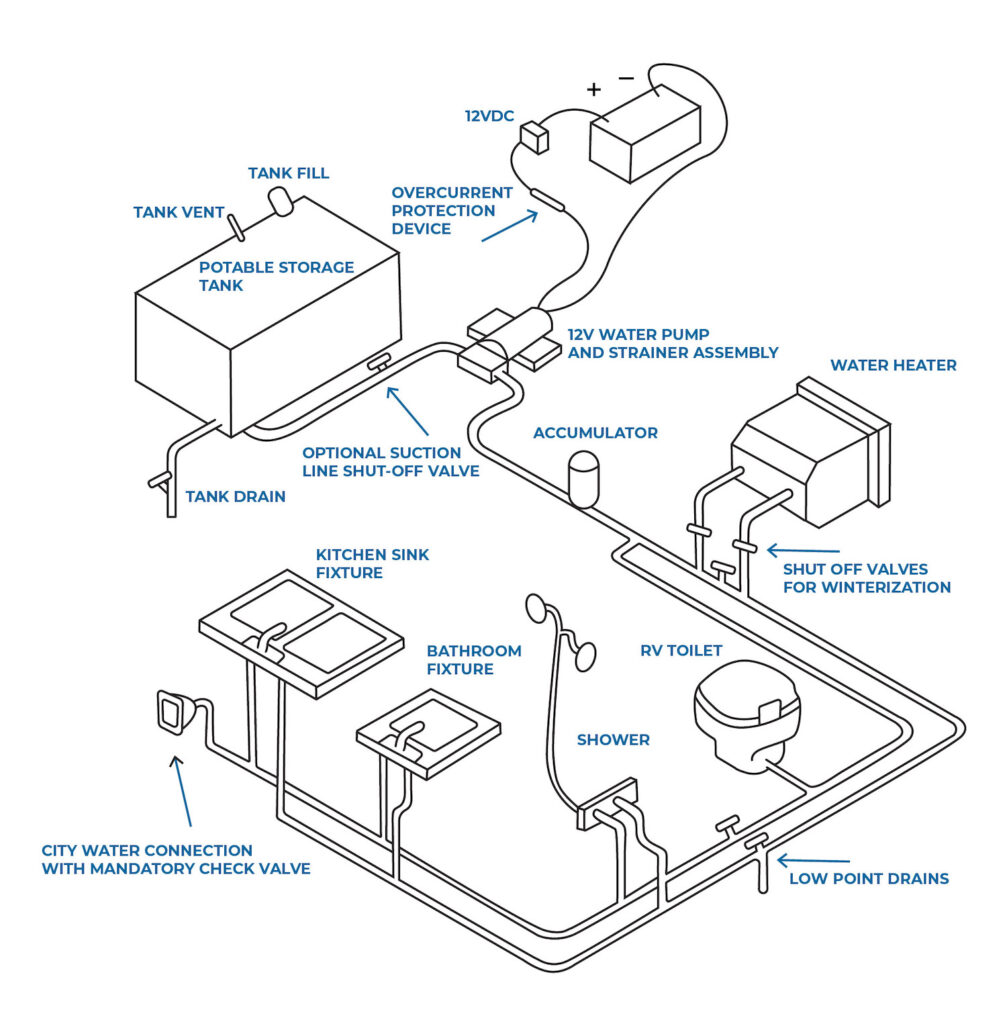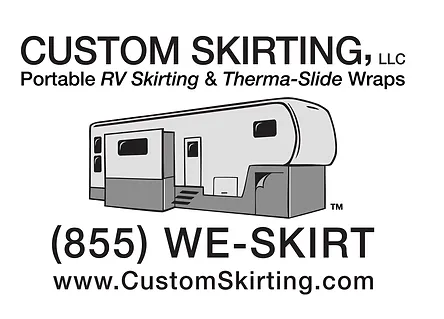
How RV Water Systems Work
Table of contents
In the world of recreational vehicles (RVs), understanding the intricacies of the water system is essential whether you’re a seasoned RV owner or considering purchasing your first RV. The RV water filter system is a vital component that provides essential amenities like clean drinking water, shower facilities, and sanitation on the go. Knowing how RV water systems work empowers owners to maintain and troubleshoot these systems effectively. This guide will delve into the details of RV water systems, covering topics such as water filtration, plumbing diagrams, water hookups, and the function of the camper water pump. Whether you’re looking to enhance your RV knowledge or ensure a smooth RV experience, understanding RV water systems is key to enjoying your travels with confidence.
RV Water System Components
Pressure Regulator
The pressure regulator in an RV water system regulates the water pressure to prevent damage to the plumbing and fixtures. It’s typically installed at the water hookup or inlet of the RV.
RV Water Filter Systems
RV water filter systems are used to remove impurities and contaminants from the water supply. They can be installed in line with the water system to ensure clean water for drinking and general use.
Fresh Water Tank
The freshwater tank holds the onboard water supply for the RV. It’s where water is stored for use when camping without a hookup. Fresh water tanks can be located underneath the RV or inside storage compartments.
In-line Strainer
An in-line strainer is used to filter out larger particles and debris from the water before it enters the plumbing system. It helps prevent clogs and damage to the camper water pump and fixtures.
Water Pump
The camper water pump pressurizes the water from the freshwater tank and delivers it to the RV’s plumbing system. It’s typically located near the freshwater tank and is powered by the RV’s electrical system.
Shut-Off Valve
Shut-off valves are installed at various points in the RV water system to control the flow of water. They allow you to isolate specific areas of the plumbing for maintenance or repairs.
Piping/Tubing
Piping or tubing refers to the network of pipes that carry water throughout the RV. They connect the various components of the water system, including fixtures, tanks, and appliances.
Accumulator
An accumulator is a pressure storage tank that smooths out water flow from the camper pump, reducing pump cycling and providing a more consistent water pressure.
Water Heater
The water heater heats water for bathing and washing dishes. It can run on propane, electricity, or a combination of both. Water heaters are typically located inside the RV and have a dedicated tank for hot water storage.
Fixtures
Fixtures include faucets, showerheads, and toilets where water is used. They are connected to the plumbing system and allow for water use inside the RV.
Low-Point Drains
Low-point drains are located at the lowest points in the plumbing system and are used to drain water from the system for winterization or maintenance. They help prevent water from freezing and damaging the pipes during cold weather.

RV Water System RV Plumbing Diagram
It’s important to note that this general diagram may vary depending on your RV model and configuration. For accurate information about your RV’s water system diagram, always consult your owner’s manual or contact your RV manufacturer directly. They can provide an up-to-date and precise diagram tailored to your specific RV model and year of manufacture. This ensures that you have the most accurate information for understanding and maintaining your RV’s water system effectively.

Accessing Freshwater
When it comes to accessing freshwater in your RV, there are two primary methods:
Water Pump
To use your water pump, start by filling up your RV’s freshwater tank with clean water. Then, turn on the water pump, and water should begin flowing from your sinks and shower head. This method is ideal when you’re camping without any hookups. Keep in mind that your water pump operates off your RV’s battery, so be mindful of turning it off when not in use to conserve battery power.
City Water Connection
For a city water connection, take a hose and connect one end to your RV and the other end to the water spigot at the hookup site. Once both ends of the hose are securely connected, turn on the water spigot. This connection provides immediate access to clean water. Whenever you connect to city water, it’s advisable to use a water pressure regulator and a water filter system to control water pressure and ensure water cleanliness as it enters your RV. These precautions help protect your RV’s plumbing system and ensure a reliable water supply during your travels.
Dumping Your RV Tanks: A Step-by-Step Guide
When your RV tanks are full or you’re preparing to wrap up your trip, it’s important to properly dump your gray water and black water tanks. Here’s a step-by-step guide to the process:
- Prepare Your Sewer Hose:
- Use a dedicated sewer hose designed specifically for dumping RV tanks. Connect one end securely to your RV’s outlet and the other end to the dump station drain.
- Dump the Black Tank:
- Begin by pulling the valve for your black tank. Always dump your black tank first to flush out any solids or build-up that might accumulate. This sequence helps prevent residue from the black tank remaining in the hose.
- Dump the Gray Tank:
- After the black tank is emptied, close its valve and then open the valve for your gray tank. Gray water can help flush out the hose and clean the system.
- Use a Proper Dump Station:
- Ensure you’re using a designated dump station for disposing of your gray water. Dumping gray water in unauthorized areas can lead to environmental issues and legal repercussions.
- Rinse Your Sewer Hose:
- After both tanks are fully emptied, disconnect the sewer hose from your RV. Keep the other end connected to the dump station drain. Use a separate rinsing hose (dedicated solely for this purpose) to flush out any residue or debris from inside the sewer hose.
- Clean and Sanitize:
- Once the sewer hose is rinsed and stowed away, take a few moments to clean and sanitize the surrounding area. Use disinfectants or sanitizing wipes to ensure a hygienic environment.

How to Maintain Your RV Water System
Proper maintenance of your RV water system is essential for ensuring a clean and reliable water supply during your travels. Here’s a guide on how to maintain your RV water system effectively:
- Use Pressure Regulators and Water Filters:
- When connecting to city water, always use a water pressure regulator to protect your RV’s plumbing from high water pressure. Additionally, use a water filter systems to ensure clean and safe water enters your RV.
- Utilize Water filter systems for Freshwater Tank Fill-Up:
- When filling your fresh water tank from a potable water source, use a water filter to remove impurities and contaminants, ensuring your tank remains clean and safe.
- Regularly Sanitize Your Fresh Water Tank:
- Sanitize your fresh water tank before each use to eliminate bacteria and maintain water quality. Many RVers perform this annually after de-winterizing their RV or when the vehicle has been unused for an extended period. Follow the recommended guidelines for sanitizing your specific tank.
- Drain Your Water Heater and Inspect the Anode Rod:
- Regularly drain your water heater to remove sediment buildup and maintain its efficiency. Additionally, inspect the anode rod in steel tanks to ensure it’s in good condition and replace it if necessary to prevent corrosion.
- Winterize Your RV Properly:
- Before winter sets in, properly winterize your RV’s water system to prevent freezing and damage. One effective method is to add a Custom RV Skirt, which provides insulation and protection against harsh winter conditions. The skirt helps maintain interior warmth, reducing the strain on heating systems and preserving the water system.
Experience Unrivaled Protection with Custom RV Skirting!
Ensure your RV’s safety and comfort with our top-notch custom skirting solution. We tailor skirting on-site for a perfect fit, offering unmatched protection against water, snow, and wind. Our innovative “No-Snap, No-Gap” channel system sets us apart, delivering superior performance in any climate. Tested rigorously in the harshest winters across North America, our skirting is the preferred choice of RV enthusiasts. Enjoy convenience and durability—get Custom Skirting today and elevate your RV experience!
